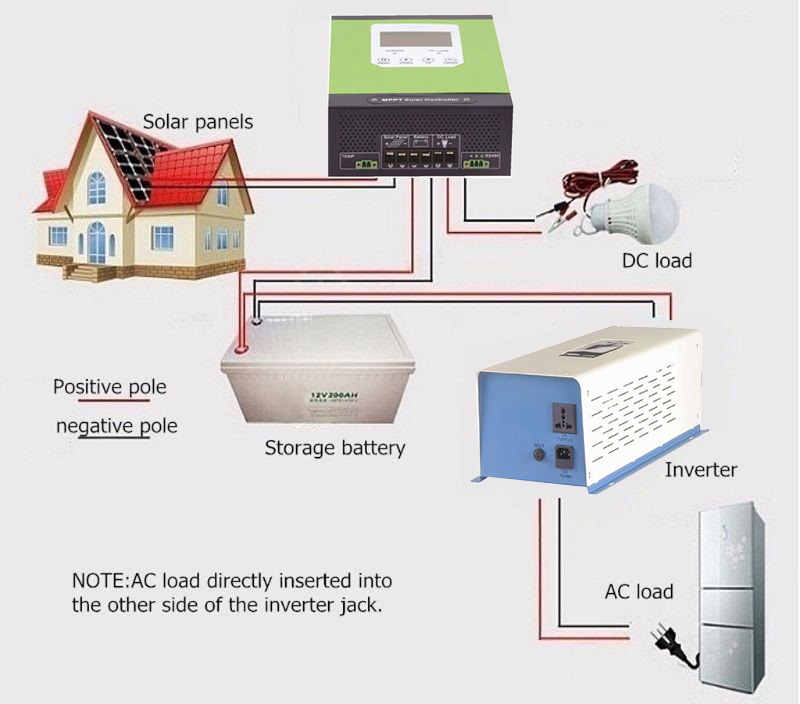A solar charge controller is an essential component in a solar power system, particularly in off-grid and battery-based solar installations. It regulates the voltage and current coming from the solar panels to the batteries, ensuring they are charged efficiently and safely. The solar charge controller is the heart of the off-grid solar system, so we need to pay special attention to selecting and sizing. Thus, we can fully utilize our solar power system. Here are the main basics, functions, and types of solar charge controllers.
Solar charge controller basic
The solar charge controller is an electronic device that works as a voltage and current regulator in an off-grid solar system. It is used to charge batteries from solar panels during daytime hours and discharge batteries when there is not enough power coming from the sun or during night hours.
So, its main function is to protect batteries from overcharging or deep discharging under operation conditions. Without this regulation, the batteries may be subject to damage as the charging voltage coming from solar panels varies and may go above the max charging voltage level of batteries.
Other benefits we get from the solar charge controller is to prevent power reversing from batteries to solar panels at night when no power coming from the solar system, provide solar panel short circuit protection, and also regulate voltage/current required for feeding small DC loads.
Moreover, modern charge controllers, have a display showing us important measurements like solar input DC current/voltage, batteries charging voltage/current, DC load current …etc. From this information, we can always be informed of the state of charging.
The main types of solar charge controller
In the market, you will see two types with two different technologies, the first is the PWM charge controller (Pulse Width Modulation) and the second is the MMPT charge controller (Maximum Power Point Tracking).
There exists a big difference between them. And let us clarify the main difference as follows.
When the MMPT charge controller receives a higher voltage from the solar panels (Vmp) than batteries charging voltage level, it reduces the voltage to match the charging battery's level, but while reducing the voltage, it increases the current, so charging power will increase as well. The result is that the charge controller has succeeded in increasing its output battery charging power, consequently achieving higher efficiency and reducing losses.
But for the PWM solar charge controller, it just reduces the voltage to match the battery's voltage charging level while the current is still the same, so the battery's charging power is the same. As a result, the PWM charge controller has failed to make use of all solar panel power, consequently lower efficiency and higher losses.
The function of solar charge controllers
- Protect the battery: Solar charge controllers have the function of preventing overcharging and over-discharging of the battery. When the power generated by the solar panel exceeds the system load and the battery storage capacity, the controller will automatically cut off the charging current to prevent the battery from being damaged by overcharging. Similarly, when the battery discharges to the set low voltage threshold, the controller will cut off the load connection to prevent the battery from over-discharging.
- Improve efficiency: High-end solar charge controllers use maximum power point tracking (MPPT) technology. MPPT technology can detect the output voltage and current of the solar panel in real-time and find its maximum power (MPP), thereby ensuring that the solar panel always charges the battery with the highest efficiency. This can significantly improve the overall efficiency and energy utilization of the system.
- Manage system parameters: Solar charge controllers can set and manage key parameters in the system, such as charging voltage, discharge voltage, charging current, etc. The settings of these parameters can be adjusted according to the specific needs of the system and the performance of the battery to achieve optimal energy management and utilization.
- Intelligent control: Modern solar charge controllers usually have intelligent control functions, which can automatically adjust the charging strategy according to factors such as light intensity and battery status. For example, when there is sufficient light, the controller may use fast charging mode; when the light is weak, it may reduce the charging current to extend battery life.
